
The garden pansy is a type of polychromatic large-flowered hybrid plant cultivated as a garden flower. It is derived by hybridization from several species in the section Melanium of the genus Viola, particularly V. tricolor, a wildflower of Europe and western Asia known as heartsease. It is sometimes known as V. tricolor var. hortensis, but this scientific name is ambiguous. While V. tricolor var. hortensisGroenland & Rümpler is a synonym of Viola × wittrockiana, V. tricolor var. hortensisDC. refers to a horticultural variety of wild pansy that had been illustrated in Flora Danica in 1777 before the existence of Viola × wittrockiana.

Hyacinthus is a small genus of bulbous herbs, spring-blooming perennials. They are fragrant flowering plants in the family Asparagaceae, subfamily Scilloideae and are commonly called hyacinths. The genus is native predominantly to the Eastern Mediterranean region and Afrotropical realm, although naturalized more widely.
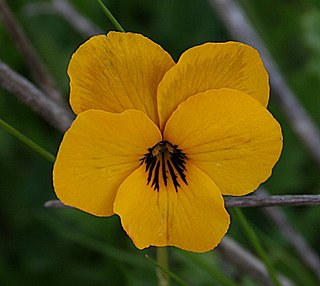
Viola pedunculata, the California golden violet, Johnny jump up, or yellow pansy, is a perennial yellow wildflower of the coast and coastal ranges in California and northwestern Baja California. The common name "Johnny jump up" is usually associated with Viola tricolor however, the introduced garden annual.

Viola riviniana, the common dog-violet, is a species of flowering plant in the family Violaceae, native to Eurasia and Africa. It is also called wood violet and dog violet. It inhabits woodland edges, grassland and shady hedge banks. It is found in all soils except those which are acid or very wet.

Viola odorata is a species of flowering plant in the family Violaceae, native to Europe and Asia. This small hardy herbaceous perennial is commonly known as wood violet, sweet violet, English violet, common violet, florist's violet, or garden violet. It has been introduced into the Americas and Australia.

Campanula carpatica, the tussock bellflower or Carpathian harebell, is a species of flowering plant in the family Campanulaceae.

Iris sibirica, commonly known as Siberian iris or Siberian flag, is a species of flowering plant in the family Iridaceae. It is a rhizomatous herbaceous perennial, from Europe and Central Asia. It has long green grass-like leaves, tall stem, 2–5 violet-blue, to blue, and occasionally white flowers. It is cultivated as an ornamental plant in temperate regions.

Viola sororia, known commonly as the common blue violet, is a short-stemmed herbaceous perennial plant native to eastern North America. It is known by a number of common names, including common meadow violet, purple violet, woolly blue violet, hooded violet, and wood violet.

Vinca major, with the common names bigleaf periwinkle, large periwinkle, greater periwinkle and blue periwinkle, is a species of flowering plant in the family Apocynaceae, native to the western Mediterranean. Growing to 25 cm (10 in) tall and spreading indefinitely, it is an evergreen perennial, frequently used in cultivation as groundcover.
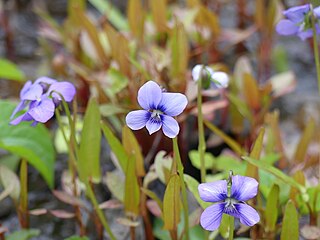
Viola cucullata, the hooded blue violet, marsh blue violet or purple violet, is a species of the genus Viola native to eastern North America, from Newfoundland west to Ontario and Minnesota, and south to Georgia. It is a recipient of the Royal Horticultural Society's Award of Garden Merit.
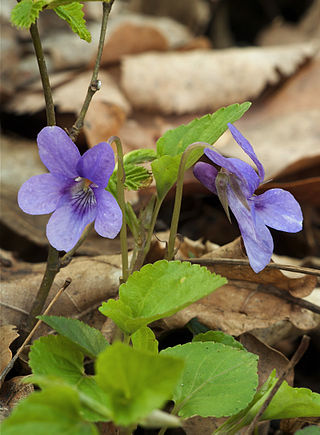
Viola reichenbachiana, also known as the early dog-violet, pale wood violet, slender wood violet, hedge violet, or wood dog violet, is a species of flowering plant in the Viola genus. This species hybridises with Viola riviniana, the common dog-violet, to produce Viola × bavarica. The plant is named after the 19th century botanist Ludwig Reichenbach. It is a rhizomatous herbaceous perennial that is widely known for its purple petals, and it typically resides along road banks or among other rich vegetation, as other wild pansies do. The name dog violet refers to its lack of scent, making it supposedly only fit for dogs.
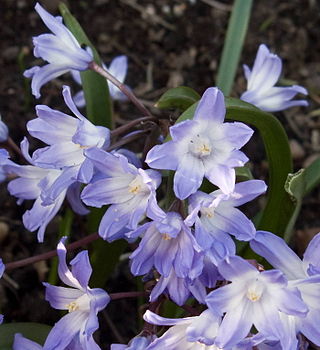
Scilla forbesii, known as Forbes' glory-of-the-snow, is a bulbous perennial plant from west Turkey flowering in early spring. It is considered synonymous with Scilla siehei, known as Siehe's glory-of-the-snow, by some sources, although others distinguish them. It belongs to a group of Scilla species that were formerly put in a separate genus, Chionodoxa, and may now be treated as Scilla sect. Chionodoxa. After flowering, it goes into dormancy until the next spring. It seeds readily to form colonies.

Viola cornuta, known as horned pansy or horned violet, is a species of flowering plant in the violet family Violaceae, native to the Pyrenees and the Cordillera Cantábrica of northern Spain at an altitude of 1,000–2,300 metres (3,300–7,500 ft). It is a low-growing, clump-forming temperate evergreen perennial, reaching 50 cm (20 in) in height and spread. It has mid-green ovate leaves with rounded teeth, and masses of delicate pale violet flowers in early summer. The flower consists of five strap-shaped petals with a slender spur.
Iris heweri is a plant species in the genus Iris, it is also in the subgenus Iris and in the section Regelia. It is a rhizomatous perennial, from Afghanistan. It has tall, green curved leaves, tall slender stems and purple blue or violet-blue flowers, with white and purple or lilac beard. It is cultivated as an ornamental plant in temperate regions.
Iris dolichosiphon is a plant species in the genus Iris, it is also in the subgenus Iris and in the section Pseudoregelia. It is a rhizomatous perennial, from China and Bhutan. It has long, thin dark green leaves, very short stem, and dark blue, purple, or violet flowers. That are mottled with white. It has thick white/orange beards. It has one subspecies, Iris dolichosiphon subsp. orientalis, from China, India and Burma. It has similar flowers. They are cultivated as ornamental plants in temperate regions
Iris schachtii is a plant species in the genus Iris, it is also in the subgenus Iris. It is a rhizomatous perennial, from central Anatolia, in Turkey. It has small, thin grey-green leaves, a short stem with 1–3 branches, which are normally, covered with a green leaf with purple staining. It has 2 or more fragrant flowers in late spring, which come in shades of yellow or purple, or violet and yellow,. It has a yellow or white with yellow-tips beard. It is cultivated as an ornamental plant in temperate regions, but prefers regions with dry, hot summers.
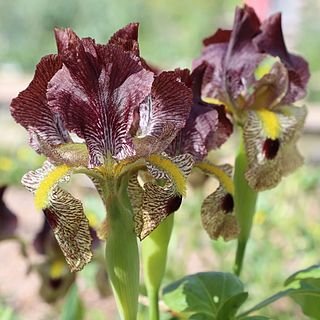
Iris paradoxa is a species of flowering plant native to western Asia. It has large upright petals and smaller lower petals, which is unique amongst most iris forms. They come in various shades from white, lavender, mauve, medium purple, violet, dark purple to black. It has a black or purplish black beard on the lower petals. It comes from the region of Transcaucasia, and is found in the countries of Iran, Turkey, Armenia and in Azerbaijan.

Primula scandinavica is a species of flowering plant in the family Primulaceae.

Primula algida is a species of flowering plant within the family Primulaceae. This species was first described by Michael Friedrich Adams.
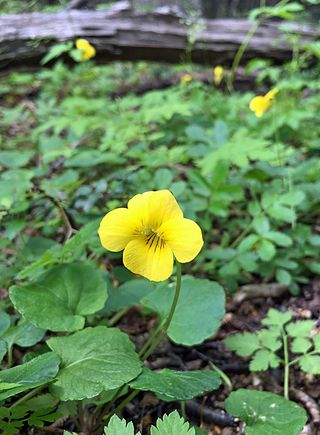
Viola reichei, also known as the Patagonian yellow violet, is a flowering plant species of the genus Viola.

















